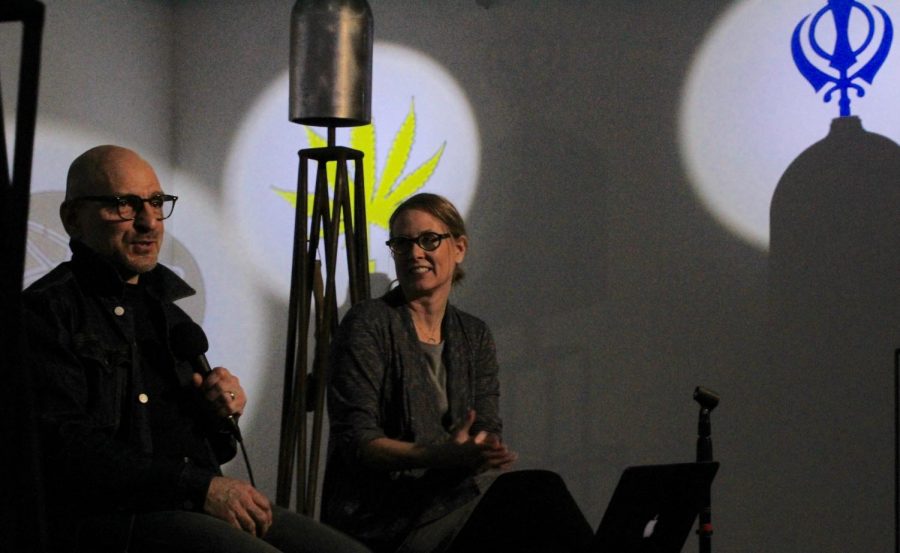Art show breaks through the noise
Nick Minges – The State Hornet
Sac State professor Andrew Connelly (left) addresses attendees with Crocker Art Museum curator and Sac State professor Diana Daniels. He he gave an hour-long talk about the project’s origins followed by a question and answer session.
February 5, 2018
Sacramento State professor Andrew Connelly spoke during the reception for “All Exaltations: Meditations in Sculpture” as the exhibit’s room filled to capacity Feb. 1, forcing attendees to listen and view from a livestream outside.
The reception was held in the Robert Else Gallery in Kadema Hall.
Spectators, many of them students of Connelly’s, sat cross legged around him while he gave an hour-long talk about the project’s origins followed by a question and answer session.
Connelly has been a professional artist since the early ‘90s and a teacher at Sac State since 2003. His work has been featured in museums and galleries around the country as well as in several magazines.
More recently, he’s been working in locations such as Chile, Mexico and Columbia with the artist collective ARTNAUTS, which is bring art to other regions of the world.
RELATED: Art professor brings outside experience to campus exhibit
The sculptures themselves consisted of salvaged propane tanks which were repurposed as bells and topped with brightly colored symbols from around the world, which were projected onto the walls by small spotlights mounted to the ceiling.
Getting the sculptures off the ground, however, required some work.
“The tripods sucked,” Connelly said, recalling his attempt to raise the sculptures. “They weren’t stable enough.”
But the project expanded and took on greater meaning when he “started to go back to look at these pieces of architecture.”
He then decided to fix the bells atop scale models of iconic buildings from around the globe.
“Growing up on Long Island, I watched the World Trade Center go up,” he said. “I began with [it] and incorporated all these other cities.”
The new One World Trade Center, the successor to the twin towers, is also included in the set with each building modeled to scale.
Connelly was accompanied by Diana Daniels, a curator from The Crocker Art Museum who also teaches here at Sac State.
“The big moment for me is when we made [the bells] ring,” Daniels said.
[su_carousel source=”media: 39010,39009″ limit=”98″ link=”lightbox” width=”1600″ height=”900″ items=”1″ title=”no” pages=”yes” autoplay=”0″ speed=”400″][su_carousel source=”media: 36168,36123,36121,36118,36113,36110,36109,36108″ limit=”98″ width=”1400″ height=”1000″ items=”1″ title=”no” autoplay=”0″ speed=”400″][su_carousel source=”media: 34486,34485,34484,34483,34482,34481,34480,34478,34477″ limit=”98″ width=”1280″ height=”720″ items=”1″ autoplay=”0″ speed=”400″ title=”yes”]”[/su_carousel]
She had initially harbored a latent concern about their appearance because they “looked like World War II munitions.”
But her first striking of the bells she says “calmed [her] unease.”
The bells have a deep and penetrating sound that sent vibrations outward with a meditative hum. Not coincidentally, bells of a similar nature have been used in eastern meditation rituals for ages. The sound “transforms a mindset,” said Daniels.
Connelly hints they may also be used in a musical collaboration in the future.
His aim, he said, was to “recreate what was going on in the ‘60s and ‘70s,” and the symbols atop the bells nod not only to world religions and cultures, but to space travel and cannabis use.
Art student Bliss Morton said that the ringing of the bells serves as a metaphor for the need for us in the modern world to “transcend the chaos,” as art student Bliss Morton puts it.
Connelly and Daniels spent time placing each sculpture to create a “feeling of relief.”
Percussion mallets hung from the sculptures and guests were encouraged to transcend as much chaos as they could. The ringing bells could be heard on campus long after dark.
Art Studio major Valerie Dacpano asked the artist if there was anywhere in the world that he wanted to put the pieces permanently, but Connelly just laughed and said, “nothing is permanent.”
































































































































